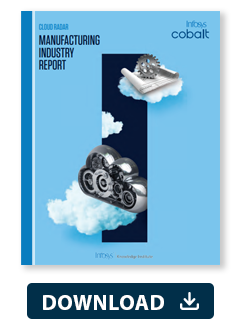Executive summary
Cloud computing has moved up the product value chain for manufacturing. The most popular use cases for cloud are essential research, development, and new product design. Companies unlock innovative capabilities on cloud, yet they must also navigate challenges such as cost, security, and governance.
New product development has long been a strategic activity in the product life cycle (Figure 1). Pandemic-induced shutdowns in 2020 drove manufacturers to shift to cloud-based product development and remote collaboration. This shift was both immediate and substantial. Infosys Cloud Radar 2021 ranked cloud-based engineering and product development as the industry’s second most popular cloud computing use case, behind quality control visibility.
Figure 1. Cloud-based product life cycle: from engineering to manufacturing to aftermarket
Source: Infosys Knowledge Institute
“There is a narrow window of opportunity for manufacturers to reimagine business and harvest today’s opportunities to thrive tomorrow,” says Jasmeet Singh, executive vice president and global head of manufacturing at Infosys. “With end products becoming more software-intensive, connected and sophisticated, manufacturers are accelerating digital engineering to innovate and disrupt, while drawing on the efficiencies and flexibility offered by cloud.”
New product development is currently grappling with supply chain and talent challenges. These issues contribute significantly to model launch delays, especially in the automotive sector. Thirty-four percent of vehicle launches in 2023 experienced production delays, a nearly seven-fold increase from 5% in 2018. Vehicle electrification and emerging technologies such as sensors increase complexity in ways beyond typical supply chain and talent issues. Cloud-based engineering mitigates product development risks through a unified, secure platform for visibility, collaboration, and timely alerts. In Infosys Cloud Radar’s latest research report, research and development (R&D), and product development has emerged as the highest-ranked use case for cloud computing in manufacturing and automotive.
Beyond new product development, industrial executives move to cloud for growth and transformation, specifically to integrate acquisitions or subsidiaries, access new technologies, enable new revenue streams or products, and update outdated systems (Figure 2). Manufacturers hesitate to invest in cloud systems for mature functions like testing and quality control. Instead, they prioritize cloud for system integration across the enterprise.
Figure 2. Companies want growth and transformation from cloud
Source: Infosys Knowledge Institute
“Cloud has become the locus for innovation and collaboration among manufacturers,” says Anant Adya, executive vice president for Infosys Cobalt. “From design and engineering phases all the way to supply chain management, companies can operate with more clarity and adjust rapidly to changing business environments.”
“Cloud technologies offer tremendous opportunity for product design and manufacturing. This is accomplished through virtually unlimited cloud storage, high-performance computing, and global scale,” says Wendy Bauer, vice president and general manager of automotive and manufacturing at AWS. “Working collaboratively with customers and implementation partners, the industrial sector is on the precipice of unlocking the next evolution in modern manufacturing and is realizing the benefits of infusing cloud technology for a better customer experience.”
Growth and transformation initiatives emerged as the highest-ranked use cases for cloud computing in manufacturing.
Cloud works for design and R&D
Carrier is a leading manufacturer of HVAC systems, and the company has a deceptively complex ecosystem to procure, design, build, distribute, install, and maintain its offerings. Their ecosystem includes dozens of engineering applications with more than 3,000 global users, tightly integrated with other enterprise systems. This Infosys client needed an engineering digital thread to connect its manufacturing data structures, while protecting and maintaining its engineering assets. Product innovation tool enhancement was also needed, while updating and extending primary engineering tools.
Carrier migrated its engineering tools from on-premises to AWS cloud, achieving operational, security, reliability, performance, and cost targets. The new system reduced costs by 40% and provided flexibility to scale up or down, with a 50% performance improvement for specific use cases.
Cloud-powered generative design
Generative design offers manufacturers the ability to generate hundreds of different design options based on constraints selected by the user, such as material type, weight, cost, and manufacturing methods. Enhancing those capabilities via the cloud increases manufacturer productivity and accelerates time-to-market by optimizing work definition and streamlining task execution.
PIX Moving is the innovative partner of Autodesk and UC Berkley, becoming the next generation of smart vehicle production, specializing in autonomous mobility device and vehicle design. The firm used Autodesk generative design (via AWS cloud) to create its Robobus, which uses its famous “ultra-skateboard design” as the cornerstone of smart vehicle production at scale. This autonomous driving vehicle is equipped with a customizable interior, which customers design according to their needs. PIX Moving markets Robobus to retailers and enterprises with custom requirements, with use cases ranging from mobile cafes and yogurt stores to on-demand offices. Designing Robobus presented unique challenges; PIX Moving needed to balance weight and structural strength and to optimize the bus interior to maximize space. Using generative design, the company overcame these obstacles and produced Robobus’s interior decoration in less than two months.
Generative design only scratches the surface, however. With the power of generative AI, manufacturers can apply additional technology across their processes and operating models to unlock rich data insights. They can then optimize product feature road maps, supply chains, and even end-customer experiences.
Cloud in manufacturing
In 2016, computer hard drive manufacturer Western Digital acquired Hitachi GST and SanDisk. That meant merging three different cultures, three heavily customized enterprise resource planning (ERP) systems, three data sources, and three thousand applications across manufacturing, supply chain, planning, and finance departments. Regardless of the underlying post-merger integration complexity, Western Digital needed to maintain its agility during and post-acquisition. This required Western Digital to harmonize and standardize processes across these three Fortune 500-sized companies, and cloud-first infrastructure improved accuracy and trust in the system.
This Infosys client used Oracle Fusion as its cloud-based ERP, and the initial program phases transitioned finance, indirect procurement, and order management functions to cloud for financial reporting. Later phases focused on transforming manufacturing, inventory operations, and intercompany finance across 10 manufacturing plants in five countries. The client realized faster time-to-market with reduced operations cost, enhanced collaboration, harmonized processes, and a single ERP system.
Cloud in aftermarket
Elevator and escalator industry leader KONE, in its pursuit of new business streams, partnered with Infosys to build a digital core on AWS cloud. Beyond traditional installations and servicing, KONE aimed to create novel customer experiences in the flow of urban life.
These experiences mirror our research findings. Companies surveyed say they are pleased with what cloud delivers. Of 412 manufacturers and automotive companies surveyed by Infosys, 73% say cloud migration efforts are very effective or extremely effective (Figure 3). This aligns with the sentiments of most large companies in our survey.
Figure 3. Cloud migration initiatives are very effective or extremely effective for 73% of respondents
Source: Infosys Knowledge Institute
Manufacturing cloud spending a bit below average
Our research found that manufacturers spend $30 million annually for cloud services, slightly less than our global average across industries (Figure 4).
Figure 4. Average cloud spend comparison, with automotive and manufacturing slightly less than the global average
Source: Infosys Knowledge Institute
Manufacturers tell us they have increased cloud spending and that will continue in the year ahead (Figure 5). Two out of three respondents increased cloud spending in 2023, and four out of five will do so in the following year. This is in line with overall corporate cloud trends. As cloud systems develop additional capabilities, companies increasingly turn to cloud to replace outdated technologies and add new functionality.
Figure 5. Cloud spending continues to increase
Source: Infosys Knowledge Institute
While manufacturers are ready to spend for new cloud, many aren’t using all the cloud they have already committed. Our survey found that manufacturers and automotive companies have consumed only 48% of their cloud commitments (Figure 6).
Figure 6. Percentage of consumed cloud services
Source: Infosys Knowledge Institute
A decade on, cloud has changed
The nature of corporate cloud has changed. Most companies, including manufacturers, began their cloud journey a decade ago. The prime era of initial cloud migration came in 2012-2014 (Figure 7). Those first steps were typically about adding storage and replacing outdated tech infrastructure.
Figure 7. Initial cloud migration by year
Source: Infosys Knowledge Institute
Interestingly, cloud adoption wave among manufacturers surged a touch earlier. After little cloud uptake in its early years, manufacturers jumped to it in 2010. Some 9% of all migrations to AWS, Microsoft Azure or Google Cloud Platform in manufacturing and automotive began their migration that year.
Today, cloud is not about infrastructure or storage, and it’s a singular noun. Cloud is operated as multicloud, and most often hybrid multicloud.
Manufacturers hire three to four cloud providers today. In 2021, Infosys found that most companies used two or three cloud providers, and 21% lived in a monocloud world (Figure 8). In 2023, the monocloud community for manufacturers is down to 10%. That’s actually still above the moncloud average for most industries.
Figure 8. The number of cloud service providers engaged
Source: Infosys Knowledge Institute
Industry cloud
Industries have unique nuances at each product life cycle stage, and addressing these requirements creates greater potential benefits from industry cloud platforms. Gartner notes that these platforms address specific needs in vertical industry segments, where generic solutions fall short. IT and business functions have converged to tackle industry-specific challenges through cloud solutions. Here are a few examples.
Cloud-based infrastructure. Engineering cloud technology orchestrates and integrates an organization’s engineering functions. A large global elevator manufacturer, expanding both organically and through acquisitions, sought to consolidate its product data in a single product life cycle management (PLM) system with distributed file vaults worldwide. This Infosys client implemented a cloud-based infrastructure to host their product data in a single, consolidated PLM system. They scaled infrastructure on demand and reduced PLM’s total cost of ownership by 30%. Standard parts duplication reduced by 25% across locations.
Data warehouse on cloud. Toyota’s vehicle data warehouse tracks all its cars manufactured in North America. Previously, Toyota operated an on-premises data warehouse that generated high maintenance costs and database technologies that were expensive, outdated, and not scalable. The client modernized its vehicle data warehouse by migrating to Amazon’s cloud-based offering.
Sustainability cloud. Investors and customers seek sustainable practices from solution providers. Enterprises prioritize sustainable operations, with their ERP as the system of record. Infosys leveraged SAP's tools to develop a solution to identify, track, predict, and refine carbon emissions and enable organizations to make sustainable decisions.
Sophisticated clouds bring new challenges
Cloud technology performs well with sophisticated tasks, yet advancements introduce added complexity.
Our research reveals that manufacturing cloud managers are generally confident in running their systems. But they are least confident in monitoring, predicting, and optimizing cloud costs (Figure 9). To control cost, firms review cloud applications, their usage, opportunities to consolidate and optimize underutilized instances.
Figure 9. The three factors cloud executives are least confident to manage
Source: Infosys Knowledge Institute
In addition to cost, sophisticated cloud systems open up new challenges for system security. Around 44% of manufacturing respondents allow any department head or IT manager to deploy new cloud infrastructure, software, or applications. While this might be considered lax from a security perspective, that must be balanced against the dynamic, changing demands placed upon manufacturers. Cloud applications must be designed for security from the start of the project, not as an after-thought.
The realm of cloud computing requires collaboration between business and IT stakeholders. Modern cloud requires many processes, tools, and people to work together smoothly, and that requires both technical and strategic thinking.
However, when we surveyed respondents over a range of critical cloud decisions, they indicated 43% of these decisions are made in isolation (Figure 10). In this new era, cloud saturates every aspect of the corporate enterprise. Cloud decisions need to involve business leaders, technologists, and end users from initial stages for acceptance and successful adoption.
Figure 10. Responsibility for four major cloud decisions – compliance, deploy/retire, purchase, security
Source: Infosys Knowledge Institute (N=412)
Enterprises benefit the most when they extend cloud beyond storage and computing and deploy for strategic initiatives. Cloud aids all product life cycle stages for faster decision making and data monetization. Industry clouds are specialized versions of the technology. Migrating to industry clouds enables best practices across industries, as cloud vendors implement established approaches as cloud features.
Migrating to industry clouds enables best practices with established approaches implemented as cloud features.
Recommendations
Manufacturing leaders can use cloud to improve their innovative applications through the following recommendations:
- During cloud migration, organizations should uphold an enterprise-wide, integrated life cycle perspective, as a siloed approach incurs high costs for design, implementation, and maintenance of integration between systems. Further, cloud migration that focuses on localized issues puts limits on interoperability. Along with the capability to scale rapidly, interoperability across systems and data sharing among systems are key functions of cloud. Cloud interoperability and data sharing greatly enhance the ability to share information among partners and across supply chains.
- Cloud spending for engineering and manufacturing functions will plateau in short to medium term; growth lies in aftermarket for connected products that tap into generated data streams. Aftermarket opens up revenue streams from the basic sale of spare parts, ongoing services such as maintenance and repair, to new business models. Infotainment and usage-based insurance are examples in the automotive industry. Connected products generate useful insights and build goodwill with users. This enhances loyalty and customer engagement in the near term, which potentially yields deeper insights into long-term product management and offerings.
- Business leaders must progress beyond generic cloud applications to niche, industry cloud applications to leverage best practices. Industry clouds are optimized for performance and cost. Organizations should reengineer their business processes to adapt industry cloud solutions, controlling costs of application customization, migration, training, and upgrades. An enterprise-wide cloud approach empowers organizations to offer end users customized cloud-based industry tools. The full power of cloud-driven technologies, combined with industry specialists’ expertise, enables companies to rapidly innovate and solve emerging business challenges at a 21st-century pace.
Appendix: Research approach
Qualitative interviews
To enrich insights, we conducted phone interviews with more than 50 industry practitioners, executives, and subject matter experts.
Quantitative survey
Source: Infosys Knowledge Institute
Source: Infosys Knowledge Institute

















